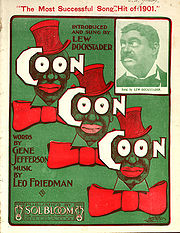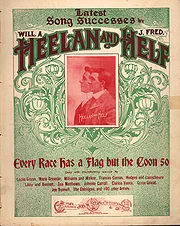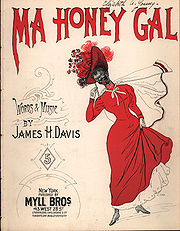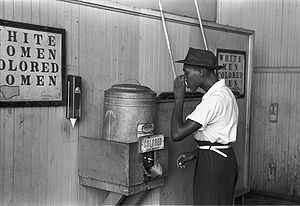
Coon song
Encyclopedia

Music genre
A music genre is a categorical and typological construct that identifies musical sounds as belonging to a particular category and type of music that can be distinguished from other types of music...
popular in the United States
United States
The United States of America is a federal constitutional republic comprising fifty states and a federal district...
and around the English-speaking world from 1880 to 1920, that presented a racist and stereotyped image of blacks
African diaspora
The African diaspora was the movement of Africans and their descendants to places throughout the world—predominantly to the Americas also to Europe, the Middle East and other places around the globe...
.
Rise and fall from popularity
The first explicitly-coon song was "The Dandy Coon's Parade" by J.P. Skelley, published in 1880. Other notable early coon songs included "The Coons Are on Parade," "New Coon in Town" (by J.S. Putnam, 1883), "Coon Salvation Army" (by Sam LucasSam Lucas
Sam Lucas was an African American actor, comedian, singer, and songwriter. His career began in blackface minstrelsy, but he later became one of the first African Americans to branch into more serious drama, with roles in seminal works such as The Creole Show and A Trip to Coontown...
, 1884), "Coon Schottische
Schottische
The schottische is a partnered country dance, that apparently originated in Bohemia. It was popular in Victorian era ballrooms as a part of the Bohemian folk-dance craze and left its traces in folk music of countries such as Argentina , Finland , France, Italy, Norway , Portugal and Brazil , Spain ...
" (by William Dressler
William Dressler
William Dressler was a cardiologist born in Poland.Dressler's syndrome is named for him.The "Dressler beat", a type of QRS complex, is also named for him.-References:...
, 1884).
By the mid-1880s, coon songs were a national craze; over 600 such songs were published in the 1890s. The most successful songs sold millions of copies. To take advantage of the fad, composers "add[ed] words typical of coon songs to previously published songs and rags."

Bob Cole (composer)
Robert Allen "Bob" Cole was an American composer, actor, playwright, and stage producer and director.In collaboration with Billy Johnson, he wrote and produced A Trip to Coontown , the first musical entirely created and owned by black showmen. The popular song La Hoola Boola was also a result of...
, an African-American composer who had gained fame largely by writing coon songs, made somewhat unprecedented remarks about the genre. When asked in an interview about the name of his earlier comedy A Trip to Coontown, he replied, "That day has passed with the softly flowing tide of revelations." Cole's comments may have been influential, and (following further criticism) the use of "coon" in song titles greatly decreased after 1910.
On August 13, 1920, the Universal Negro Improvement Association and African Communities League
Universal Negro Improvement Association and African Communities League
The Universal Negro Improvement Association and African Communities League is a black nationalist fraternal organization founded by Marcus Garvey. The organization enjoyed its greatest strength in the 1990s, prior to Garvey's deportation from the United States of America, after which its...
created the Red, Black and Green flag
Pan-African flag
The Pan-African flag, also referred to as the UNIA flag, Afro-American flag or Black Liberation Flag, is a tri-color flag consisting of three equal horizontal bands colored red, black and green. It was originally created as an official banner to represent an international community for all African...
as a response to the song "Every Race Has a Flag but the Coon
Every Race Has a Flag but the Coon
"Every Race Has a Flag but the Coon" was a 1900 coon song written by Will A. Heelan and J. Fred Helf that was popular in the U.S. and Britain. The song followed the previous success of "All Coons Look Alike to Me", written in 1896 by Ernest Hogan. H.L. Mencken cites it as being one of the three...
" by Heelan
Will A. Heelan
Will A. Heelan was an American lyricist during the early 20th century. He collaborated with a number of composers and lyricists including E. P. Moran, Seymour Furth, J...
and Helf
J. Fred Helf
J. Fred Helf was an American composer and sheet music publisher during the early 20th century.Helf was born in Maysville, Kentucky. He went to seek his fortune in New York City at the age of 31. There he composed over 100 songs, some in collaboration with Will A. Heelan.In October 1910 his music...
. That song along with "Coon Coon Coon" and "All Coons Look Alike To Me" were identified by H.L. Mencken as being the songs which firmly established the term "coon" in the American vocabulary.
Composers


Tin Pan Alley
Tin Pan Alley is the name given to the collection of New York City music publishers and songwriters who dominated the popular music of the United States in the late 19th century and early 20th century...
composers, including Gus Edwards
Gus Edwards (songwriter)
Gus Edwards was an American songwriter and vaudevillian. He also organised his own theatre companies and was a music publisher.-Early life:...
, Fred Fisher
Fred Fisher
Fred Fisher was a German-born American songwriter and Tin Pan Alley music publisher. Fisher founded Fred Fisher Music Publishing Company in 1907. He was born as Albert von Breitenbach in Cologne...
(who wrote the 1905 "If the Man in the Moon Were a Coon," which sold three million copies), and Irving Berlin
Irving Berlin
Irving Berlin was an American composer and lyricist of Jewish heritage, widely considered one of the greatest songwriters in American history.His first hit song, "Alexander's Ragtime Band", became world famous...
. Even one of John Philip Sousa
John Philip Sousa
John Philip Sousa was an American composer and conductor of the late Romantic era, known particularly for American military and patriotic marches. Because of his mastery of march composition, he is known as "The March King" or the "American March King" due to his British counterpart Kenneth J....
's assistants, Arthur Pryor
Arthur Pryor
Arthur Willard Pryor was a trombone virtuoso, bandleader, and soloist with the Sousa Band. In later life, he was an American Democratic Party politician from New Jersey, who served on the Monmouth County, New Jersey Board of Chosen Freeholders during the 1930s.Pryor was born on the second floor of...
, composed coon songs. (This was meant to ensure a steady supply to Sousa's band, which performed the songs and popularized several coon song melodies.)
Most coon songs were written by whites, but some were written by blacks. Important African-American composers of coon songs include: Ernest Hogan
Ernest Hogan
Ernest Hogan was the first African American entertainer to produce and star in a Broadway show and helped create the musical genre of ragtime....
(who wrote "All Coons Look Alike to Me," the most famous coon song), Sam Lucas
Sam Lucas
Sam Lucas was an African American actor, comedian, singer, and songwriter. His career began in blackface minstrelsy, but he later became one of the first African Americans to branch into more serious drama, with roles in seminal works such as The Creole Show and A Trip to Coontown...
(who wrote the most racist early coon songs by modern standards), Sidney Perrin, Bob Cole
Bob Cole (composer)
Robert Allen "Bob" Cole was an American composer, actor, playwright, and stage producer and director.In collaboration with Billy Johnson, he wrote and produced A Trip to Coontown , the first musical entirely created and owned by black showmen. The popular song La Hoola Boola was also a result of...
(who wrote dozens of songs, including "I Wonder What The Coon's Game Is?" and "No Coons Allowed"), and Bert Williams
Bert Williams
Egbert Austin "Bert" Williams was one of the preeminent entertainers of the Vaudeville era and one of the most popular comedians for all audiences of his time. He was by far the best-selling black recording artist before 1920...
and George Walker
George Walker (vaudeville)
George Walker was an African American vaudevillian. In 1893, in San Francisco, Walker met Bert Williams, who became his performing partner. Walker and Williams appeared in The Gold Bug , Clorindy , The Policy Player , Sons of Ham , In Dahomey , Abyssinia , and Bandanna Land...
.
Characteristics
Coon songs almost always aimed to be funny and incorporated the syncopated rhythms of ragtimeRagtime
Ragtime is an original musical genre which enjoyed its peak popularity between 1897 and 1918. Its main characteristic trait is its syncopated, or "ragged," rhythm. It began as dance music in the red-light districts of American cities such as St. Louis and New Orleans years before being published...
music. Coon songs' defining characteristic, however, was their caricature of African Americans. In keeping with the older minstrel
Minstrel show
The minstrel show, or minstrelsy, was an American entertainment consisting of comic skits, variety acts, dancing, and music, performed by white people in blackface or, especially after the Civil War, black people in blackface....
image of blacks, coon songs often featured "watermelon- and chicken-loving rural buffoon[s]." However, "blacks began to appear as not only ignorant and indolent, but also devoid of honesty or personal honor, given to drunkenness and gambling, utterly without ambition, sensuous, libidinous, even lascivious." Blacks were portrayed as making money through gambling
Gambling
Gambling is the wagering of money or something of material value on an event with an uncertain outcome with the primary intent of winning additional money and/or material goods...
, theft
Theft
In common usage, theft is the illegal taking of another person's property without that person's permission or consent. The word is also used as an informal shorthand term for some crimes against property, such as burglary, embezzlement, larceny, looting, robbery, shoplifting and fraud...
, and hustling
Hustling
Hustling is the deceptive act of disguising one's skill in a sport or game with the intent of luring someone of probably lesser skill into gambling with the hustler, as a form of confidence trick...
, rather than working to earn a living, as in the Nathan Bivins song "Gimme Ma Money":
Last night I did go to a big Crap game,
How dem coons did gamble wuz a sin and a shame...
I'm gambling for my Sadie,
Cause she's my lady,
I'm a hustling coon, ... dat's just what I am.
Coon songs portrayed blacks as "hot," in this context meaning promiscuous and libidinous. They suggested that the most common living arrangement was a "honey" relationship (unmarried cohabitation
Cohabitation
Cohabitation usually refers to an arrangement whereby two people decide to live together on a long-term or permanent basis in an emotionally and/or sexually intimate relationship. The term is most frequently applied to couples who are not married...
), rather than marriage.
Blacks were portrayed as inclined toward acts of provocative violence. Razor
Razor
A razor is a bladed tool primarily used in the removal of unwanted body hair through the act of shaving. Kinds of razors include straight razors, disposable razors and electric razors....
s were often featured in the songs and came to symbolize blacks' wanton tendencies. However, violence in the songs was uniformly directed at blacks instead of whites (perhaps to discharge the threatening notion of Black violence amongst the coon songs' predominantly white consumers). Hence, the specter of black-on-white violence remained but an allusion. The street-patrolling "bully coon" was often used as a stock character in coon songs.
The songs showed the social threats that whites believed were posed by blacks. Passing
Passing (racial identity)
Racial passing refers to a person classified as a member of one racial group attempting to be accepted as a member of a different racial group...
was a common theme, and blacks were portrayed as seeking the status of whites, through education and money. However, blacks rarely, except during dream sequence
Dream sequence
A dream sequence is a technique used in storytelling, particularly in television and film, to set apart a brief interlude from the main story. The interlude may consist of a flashback, a flashforward, a fantasy, a vision, a dream, or some other element. Commonly, dream sequences appear in many...
s, actually succeeded at appearing white; they only aspired to do so.
Use in theater
Coon songs were popular in VaudevilleVaudeville
Vaudeville was a theatrical genre of variety entertainment in the United States and Canada from the early 1880s until the early 1930s. Each performance was made up of a series of separate, unrelated acts grouped together on a common bill...
theater, where they were delivered by "coon shouters," who were typically white females. Notable coon shouters included Artie Hall
Artie Hall
Artie Hall was an American vaudeville singer and actress, known for her blackface performances as a coon shouter. She was a "petite vocalist with a strong voice". Her most successful role was Topsy in Willian A. Brady's version of Uncle Tom's Cabin. A controversial part of her act was the...
, Sophie Tucker
Sophie Tucker
Sophie Tucker was a Russian/Ukrainian-born American singer and actress. Known for her stentorian delivery of comical and risqué songs, she was one of the most popular entertainers in America during the first half of the 20th century...
, and May Irwin
May Irwin
May Irwin , was a Canadian actress, singer and star of vaudeville.-Early life and career:Born at Whitby, Ontario 1862 as Georgina May Campbell, her father, Robert E. Campbell of Whitby, Ontario, died when she was 13 years old and her stage-minded mother, Jane Draper, in need of money, encouraged...
.

Effects on African-American music
Coon songs, ironically, contributed to the development and acceptance of authentic African-American music. Elements from coon songs were incorporated into turn-of-the-century African American folk songs, as was revealed by Howard W. OdumHoward W. Odum
Howard Washington Odum was an American sociologist.-Biography:...
's 1906-1908 ethnomusicology
Ethnomusicology
Ethnomusicology is defined as "the study of social and cultural aspects of music and dance in local and global contexts."Coined by the musician Jaap Kunst from the Greek words ἔθνος ethnos and μουσική mousike , it is often considered the anthropology or ethnography of music...
fieldwork. Similarly, coon songs lyrics influenced the vocabulary
Vocabulary
A person's vocabulary is the set of words within a language that are familiar to that person. A vocabulary usually develops with age, and serves as a useful and fundamental tool for communication and acquiring knowledge...
of the blues
Blues
Blues is the name given to both a musical form and a music genre that originated in African-American communities of primarily the "Deep South" of the United States at the end of the 19th century from spirituals, work songs, field hollers, shouts and chants, and rhymed simple narrative ballads...
, culminating with Bessie Smith
Bessie Smith
Bessie Smith was an American blues singer.Sometimes referred to as The Empress of the Blues, Smith was the most popular female blues singer of the 1920s and 1930s...
's singing in the 1920s.
Black songwriters and performers who participated in the creation of coon songs profited commercially, enabling them to go on to develop a new type of African American musical theater
African American Musical Theater
-Early History:Before the late 1890s, the image portrayed of African-Americans on Broadway was a "secondhand vision of black life created by European-American performers." Stereotyped "coon songs" were popular, and blackface was common....
based at least in part on African-American traditions. Coon songs also contributed to the mainstream acceptance of ragtime
Ragtime
Ragtime is an original musical genre which enjoyed its peak popularity between 1897 and 1918. Its main characteristic trait is its syncopated, or "ragged," rhythm. It began as dance music in the red-light districts of American cities such as St. Louis and New Orleans years before being published...
music, paving the way for the acceptance of other African-American music. Ernest Hogan
Ernest Hogan
Ernest Hogan was the first African American entertainer to produce and star in a Broadway show and helped create the musical genre of ragtime....
, when discussing his "All Coons Look Alike to Me" shortly before his death, commented:
Coon songs in Britain
Coon songs became tremendously popular in Britain after the 1880s. Racial stereotyping in Britain had a different role than in America, in that the theatre audiences listening to the song often did not see black people on a day to day basis in their lives. However, the coon song stereotypes no doubt helped justify British expansionism in Africa in this period.In Britain, the most important stars to popularize coon songs were Eugene Stratton
Eugene Stratton
Eugene Augustus Rühlmann was born in Buffalo, New York. He adopted the stage name Eugene Stratton, and became an American-born dancer and singer, whose career was mostly spent in British Music halls.- Biography :...
, G. H. Elliott
G. H. Elliott
G. H. Elliott was a British music hall singer and dancer. He was born George Henry Elliott in Rochdale, Lancashire in 1882Known as the "Chocolate Coloured Coon", he came on stage with a painted black face but dressed entirely in white...
and G. H. Chirgwin. "Coon imitators" singing these songs were a staple part of British music-hall until at least 1920. Initially reserved to male artists; however, a small number of women and children increasingly began to sing coon songs at the beginning of the twentieth century.
Explaining coon songs' popularity

Popular music
Popular music belongs to any of a number of musical genres "having wide appeal" and is typically distributed to large audiences through the music industry. It stands in contrast to both art music and traditional music, which are typically disseminated academically or orally to smaller, local...
business exploded in Tin Pan Alley
Tin Pan Alley
Tin Pan Alley is the name given to the collection of New York City music publishers and songwriters who dominated the popular music of the United States in the late 19th century and early 20th century...
.
However, James Dormon, a former professor of history and American studies
American studies
American studies or American civilization is an interdisciplinary field dealing with the study of the United States. It traditionally incorporates the study of history, literature, and critical theory, but also includes fields as diverse as law, art, the media, film, religious studies, urban...
at the University of Southwestern Louisiana, has also suggested that coon songs can be seen as "a necessary sociopsychological mechanism for justifying segregation
Racial segregation in the United States
Racial segregation in the United States, as a general term, included the racial segregation or hypersegregation of facilities, services, and opportunities such as housing, medical care, education, employment, and transportation along racial lines...
and subordination." The songs portrayed blacks as posing a threat to the American social order, and implicitly that they had to be controlled.
Works cited
- Abbott, Lynn, & Doug Seroff. Ragged But Right: Black Traveling Shows, Coon Songs, and the Dark Pathway to Blues and Jazz. Jackson: University Press of Mississippi (2007). ISBN 1578069017.
- Dormon, James M. Shaping the Popular Image of Post-Reconstruction American Blacks: The 'Coon Song' Phenomenon of the Gilded Age. American QuarterlyAmerican QuarterlyAmerican Quarterly is an academic journal and the official publication of the American Studies Association. The journal covers topics of both domestic and international concern in the United States and is considered a leading resource in the field of American studies. The current editor-in-chief is...
40: 450-471 (1988). - Hamm, Charles. Genre, Performance and Ideology in the Early Songs of Irving Berlin. Popular Music 13: 143-150 (1994).
- Knickerbocker, William Skinkle, "Designations for Colored Folk by H.L. Mencken" in Twentieth Century English Ayer Publishing, 1970.
- Lemons, J. Stanley. Black Stereotypes as Reflected in Popular Culture, 1880-1920. American QuarterlyAmerican QuarterlyAmerican Quarterly is an academic journal and the official publication of the American Studies Association. The journal covers topics of both domestic and international concern in the United States and is considered a leading resource in the field of American studies. The current editor-in-chief is...
29: 102-116 (1977). - Peress, MauriceMaurice PeressMaurice Peress is an American orchestra conductor, educator and author. After serving as assistant conductor of the New York Philharmonic under Leonard Bernstein beginning in 1961, Peress went on to stand as leader of the orchestra in Corpus Christi, Texas in 1962. In 1970, he also became leader...
. Dvorak to Duke Ellington: A Conductor Explores America's Music and Its African American Roots Oxford University Press, 2003. - Reublin, Richard A. and Robert L. Maine. "Question of the Month: What Were Coon Songs?" Jim Crow Museum of Racist Memorabilia website, Ferris State UniversityFerris State UniversityFerris State University is a public university with its main campus in Big Rapids, Michigan, USA. Founded in 1884 as the Big Rapids Industrial School by Woodbridge Nathan Ferris, an educator from New England who later served as governor of the State of Michigan and finally in the US Senate where...
(May 2005).

